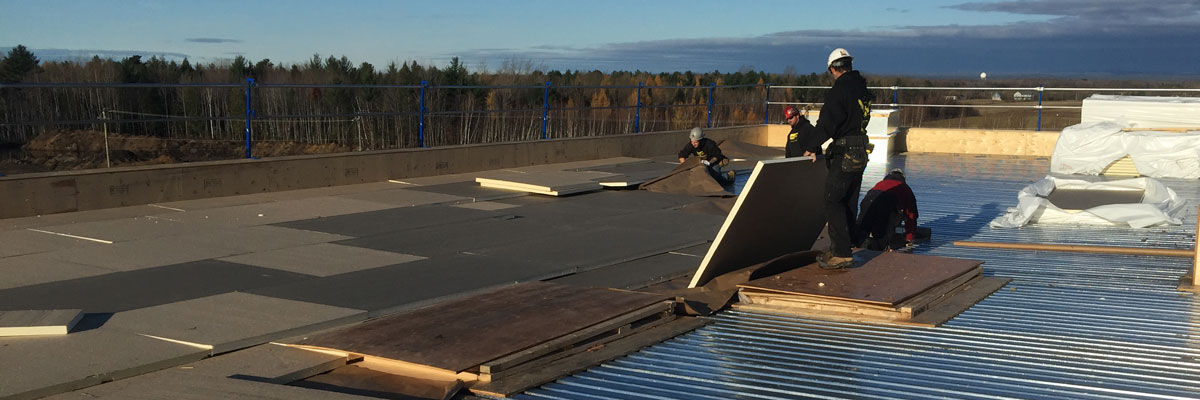Are you planning to contact a roofer about construction work?
For them to be able to answer your questions as accurately as possible, it’s best if you can tell them the pitch of the roof you want repaired or renovated.
How do you calculate and express roof pitch, and why do roofers need this information?
Find out in this article by les Couvreurs Duro-Toit.
What is roof pitch?
Roof pitch is the incline of a roof compared to a perfectly horizontal surface. It can be expressed in three different ways:
- As a ratio
- As a percentage
- As degrees of inclination
Why it’s important to know the pitch of a roof
Roofs have many features, but pitch is particularly important for planning roofing work.
For example, the pitch of a roof will affect the choice of roof covering and the amount of material needed. That means that if you want to change your roof shingles, you need to know the pitch of your roof.
The pitch also affects the flow of rainwater on the roof and the snow load it can support.
The pitch of the roof will determine the safety measures the certified roofers need to take during the roofing work in order to comply with current standards.
With all that said, it’s clear why calculating the pitch is an indispensable part of inspecting a pitched roof.
How to calculate roof pitch as a ratio
The pitch of a roof is usually expressed in inches of elevation relative to a horizontal measurement 12 inches long.
For example, a 3:12 pitch means that the roof rises 3 inches for each 12-inch horizontal run. The fraction can then be simplified so that the first number of the ratio is 1. In other words, 3:12 can be expressed as 1:4.
In order to calculate the pitch of your roof and express it in ratio form, you will need a level, a perfectly flat piece of wood and a measuring tape. As shown in the illustration below, position the piece of wood parallel to the edge of the roof for the most accurate result. Then, hold the level perfectly horizontal and measure the vertical distance between the wood and the level at exactly 12 inches from where the level meets the wood. The vertical measurement will be the first number of the ratio (3 in our example), and the second number will be 12 (for 12 inches). You can then simplify the ratio if you want to.

If you happen to have a carpenter’s square, you can also calculate the roof pitch ratio by placing a level on it. The method differs slightly, but the goal remains the same—to measure the vertical distance the roof rises along a horizontal run of 12 inches.
How to calculate roof pitch as a percentage
The pitch of a roof can also be expressed as a percentage. A perfectly flat surface has a 0% pitch, while a vertical wall has a 100% pitch.
In order to calculate the pitch of a roof as a percentage, you will need the same tools as for the previous method: a level, a flat piece of wood and a measuring tape. Proceed as though you are trying to calculate the roof pitch as a ratio, but with an additional calculation:
(height / length) * 100 = pitch as a %
That means that if you want to express the same 3:12 pitch as a percentage, you would calculate it as follows:
(3 / 12) * 100 = 25%
How to calculate roof pitch in degrees of inclination
The third method of calculating the pitch of a roof is slightly more complex. It expresses roof pitch in degrees of inclination. The result should be somewhere between 0° (a perfectly flat roof) and 90° (a perfectly vertical roof):
Just like the other two methods, you will need to measure horizontal and vertical distances using a level and a tape measure. However, you will also need the arctangent function (ATAN) in order to apply the following formula:
180° * ATAN (height / length) / π = pitch in degrees of inclination
This method is obviously more difficult to use. However, there are various free software programs on the Internet that will give you a result in degrees of inclination if you simply plug in the height and length.
Need help calculating the pitch of your roof? Contact les Couvreurs Duro-Toit
Calculating the pitch of your roof involves going up onto your roof and having the skills to handle certain tools. It’s a challenge that isn’t for everyone.
If you would prefer to entrust this task to professionals in order to avoid accidents and get reliable, precise measurements, why not contact our team of CAA Habitation-certified roofing specialists? We guarantee personalized and professional service for all flat or pitched roofing needs.



